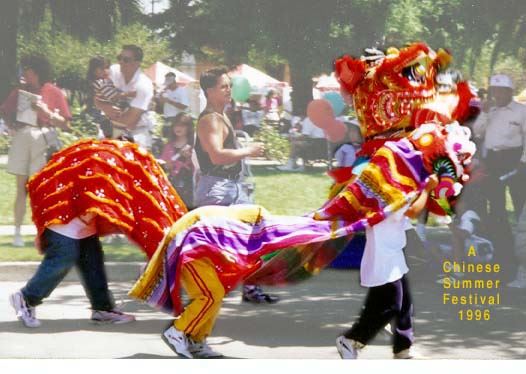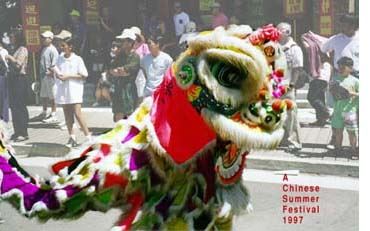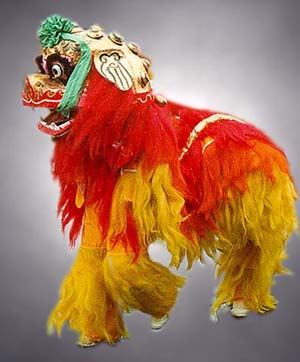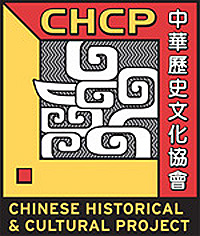|
- Home
- Chinese Lion
Chinese Lion
Southern Lion
 The Chinese Lion Dance goes back some one thousand years. The first record of the performance of an early form of the Lion Dance dates to the early Ch’in and Han Dynasties (Third Century B.C.).
The Chinese Lion Dance goes back some one thousand years. The first record of the performance of an early form of the Lion Dance dates to the early Ch’in and Han Dynasties (Third Century B.C.).
The lions express joy and happiness. From the fourth day to the fifteenth of the New Year, lion dance groups would tour from village to village in traditional China.
Both lions and dragons are featured in New Year’s Parades and other celebrations throughout the year. The Lion Dance also plays an important role in the consecration of temples and other buildings, at business openings, planting and harvest times, official celebrations, and religious rites. There are even Lion Dance competitions featuring troupes from countries as far from China as Mexico.
Northern Lion

The northern lion has a mane and four legs and is generally more realistic than the southern lion, which has a drape and can have two or four legs. One performer holds the lion’s head with both hands and another crouches at the lion’s tail. The southern lion’s head is shaped more like a dragon’s but it is without horns or a long snout. The southern lion makes dramatic head thrusts to the sound of drums and gongs; the northern lion makes great use of its prancing legs in its dance.
The following is adapted from an explanation by Don Gee
The lion dance practiced in the United States originates from the Guangdong Province. This lion and its performance are different from the Northern Lions seen in Beijing Opera or acrobatic performances. The lion dances usually are performed by members of gong-fu (kung-fu) schools and reflect that gong-fu style. For example, in Hung Gar (Hung Jia in Mandarin), the students practice very deep “horses” (stances), with the power coming from the twisting and rotation of the waist. In Choy Lay Fut (Tsai Li Fo), movements are quicker. No matter what style, the lion movements are feline in nature.
For a proper lion dance, the movements must match the music played by a minimum of three pieces: drum, gong and cymbal. Either the person performing in the lion head or the drummer initiates the movement and signals the other, so that the movement and music is synchronized. Certain movements must follow a specified sequence: for example, the 3-Star movement, then the 7-Star movement, followed by High Dance. Variations to the basic beats help keep the music lively. The loud music, along with the firecrackers and lion movements, are used to scare away “evil spirits” so that good luck will follow. Lion dances are performed to bring luck and to ward off evil spirits, as with the beginning of the Lunar New Year and grand opening of businesses, and now – minus the firecrackers – at weddings and even red egg/ginger parties celebrating the birth of a baby.
Having a lion dance team perform at a wedding is getting popular in the United States, but it usually isn’t cheap. The cost will depend on whether the wedding couple wants one or two lions, as well as how fancy a performance they want, how much experience the lion dance team has, and age of the performers. In addition, a table may also be reserved for the team to eat dinner after the performance.
Payment to the performing group is usually made through the Choy Cheng, or “Eating of the Green (Vegetable).“ In this country, it has come to symbolize money, the color of dollar bills. Usually, the lai see (li shir) is in the form of a hung bao (lucky red envelope with the payment enclosed) which is tied to some vegetable matter such as loose leaf lettuce. Since the lai see is attached to some vegetable, it’s called choy cheng, with choy literally meaning vegetable. The "greens" are placed in an area for the lion to “eat.” The lion will carefully approach the “green” and even test it to make sure that it is safe and not a firecracker or other dangerous item. After testing on the left and right sides, the lion will do a 3-Star routine (stepping to the 3-Star music) to ward off any others that may want to eat his “green.”
I’ve heard of some tests that include using a coconut, crab, or a “Seven Stars and the Moon” arrangement of oranges. Sometimes Chinese martial arts weapons representing a snake are laid down on the floor before the lettuce. This is also used to test the lion since there is a special sequence to follow before reaching the lettuce. (Some other types of etiquette that may be followed include testing the door opening, bowing to certain Buddhas represented by figurines, and bowing to and exchanging business cards with another lion dance team.)
The lion will then pick up the "green" in his mouth and “chew” it. The person manipulating the head first removes the lai see and places it inside his shirt, so as not to drop it, which would mean bad luck. Then he will tear the lettuce apart and throw it out first to the left, then to the right and then to the middle to help spread prosperity in all directions. The music will then change to High Dance and the head will be raised and moved as if the lion is happy to have consumed his prize.
I’ve seen some routines that included oranges or fish and have heard of some with coconuts or live crabs! Each routine is supposed to symbolize something. I only know of a few from watching others perform and from looking at instructional videos.
For parties, instead of the lion performing the choy cheng, or eating of the “green,” (spitting out the lettuce is too messy), usually a scroll with calligraphy wishing the couple good luck is prepared to be unfurled during the performance. For weddings, I’ve seen some calligraphy like Bac Nien Ho Hop, or “100 Years of Happy Togetherness.” This scroll can then be given to the lucky couple as a memento.
The lion dance team that I help coach did a lion dance at Dolch Electronics in Fremont recently, and since I had the day off, I was able to join them with me playing the large cymbals. I’m getting a little too old to get into the head. The team also did a performance at a Vietnamese nightclub that evening and did the Vietnamese Spring Festival parade in downtown San Jose, CA.
Our si-sook, or kung-fu uncle, came to the school of my sifu, or kung-fu master/teacher, every Friday to help purify our lion dance to the Hung Gar style, as each Southern kung-fu style (i.e. white crane, choy lay fut, yau kung moon, etc.) has their own style of lion dancing that reflects their style of kung-fu.

